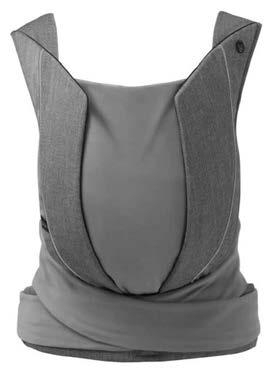
5 minute read
FOCUS ON: BREASTFEEDING
FEEDING EXPERT Clare Byam-Cook TALKS ABOUT THE NEED FOR BETTER SUPPORT FOR NEW MOTHERS, AND HOW TO FIND THE RIGHT LATCHING TECHNIQUE FOR YOU
Having taught breastfeeding classes since 1989, it continues to surprise me that the UK still has one of the lowest breastfeeding rates in the western world. Statistics show that about 30 per cent of women won’t even attempt to breastfeed their babies, and of the 70 per cent who do try, roughly half of them give up within the first six weeks. Numerous surveys show that these mothers are giving up because they find it too painful or di cult, rather than because they’re unaware of the health benefits.
SUPPORTING NEW MOTHERS
I wholeheartedly believe we ought to be more realistic when teaching breastfeeding in antenatal classes so there is less emphasis on discussing the benefits of breastfeeding and more on teaching mothers how to do it and what to do if things go wrong. There seems to be a fear that if we discuss all the potential breastfeeding problems that might arise, mothers will be put o from even trying.
Unfortunately, this policy means most mothers assume that because breastfeeding is natural, it’ll also be easy. It then comes as a shock if they find it di cult and worse still, they have no idea how to overcome common problems, such as sore nipples or di culty in latching. I also think it’s important to give mothers more information on all the breastfeeding aids that have been designed to enhance the whole experience.
And finally, we should abandon the ‘all or nothing’ approach, which leads mothers and many health professionals to believe that it’s either breastfeeding exclusively or not at all. Surely it’s better for those mothers who are struggling to try combination feeding, rather than feeling that if they give even one bottle of formula to their baby they’ve failed and should give up breastfeeding completely.
FINDING THE RIGHT TECHNIQUE FOR YOU AND YOUR BABY
The main reason why many mothers find it di cult to latch is because breasts come in all shapes and sizes. Large breasts with flat nipples make latching harder than small breasts with prominent nipples. In the past, midwives used to show mothers how to shape their breast to make it easier for their baby to latch on, but nowadays mothers are told that they must leave their baby to do it alone.
The current thinking is that the mother should align her baby’s nose in front of her nipple and then wait for her to open her mouth wide and latch on of her own accord.
The problem with this is that many babies don’t open their mouths wide enough, so they either struggle to latch on at all, or end up sucking on the nipple rather than on the breast – and this hurts!
When your baby is latched on correctly, her sucking shouldn’t hurt at all. Another bonus of a good latch is that it makes it easier for your baby to ‘milk’ your breast, which means she can feed quickly and e ciently, so feeds will often become shorter.
I recommend that you do your research before baby is born. Read books which reflect the way you would like to breastfeed your baby and keep an open mind about things like feeding on demand versus a strict routine. You may well change your views once your little one is born! LATCHING TECHNIQUE TO TRY AT HOME If the ‘nose-to-nipple’ approach isn’t working for you, you might like to try this simple technique which I teach my clients. This involves making your breasts smaller, rather than expecting baby to open her mouth wider, using the same principle as trying to post a large parcel into a small letterbox – if the opening is too narrow, you have to squash the parcel to make it fit! This is how you do it:
• Place baby on a pillow so she is level with your breast and has her mouth (rather than her nose) in front of your nipple. • Slide your hand underneath your breast and place the balls of your thumb and middle finger level with your nipple, on the outside of the areola. • Gently squeeze your breast until your nipple protrudes. • Brush your nipple against your baby’s lips until she opens her mouth, then bring her swiftly to the breast so you get as much areola as possible into her mouth. I like to call this the ‘shape-andshove’ technique!
Elvie Electric Breast Pump, £249, boots.com

Green People Soothing Nipple Balm, £10, lookfantastic.com

Lansinoh breast therapy gel pads, £12.99, mothercare.com

Ask other mothers if they’re able to recommend any equipment that they found helpful, such as breast pumps and nipple shields, and ask for their recommendations for good breastfeeding counsellors or drop-in clinics in your local area. If the experts, such as your midwife or health visitor, can’t show you how to breastfeed successfully, please don’t feel a failure if you give up. The most important thing is that your baby is well fed and that you’re both happy.
Most importantly, try not to give up on the whole process too soon. For most new mothers, breastfeeding problems are only temporary, and if you can work your way through them, you and your baby will eventually have many happy months of breastfeeding ahead of you.
Clare Byam-Cook's series of books, What to Expect When You're Breastfeeding... and What if You Can't?, Top Tips for Breastfeeding and Top Tips for Bottlefeeding and DVD, Breastfeeding Without Tears, are available to buy on Amazon, Apple Books and Google Play.
Liewood nightlight, £35, smallable.com

What to Expect When You're Breastfeeding... And What If You Can’t?, £12.99, amazon.co.uk








